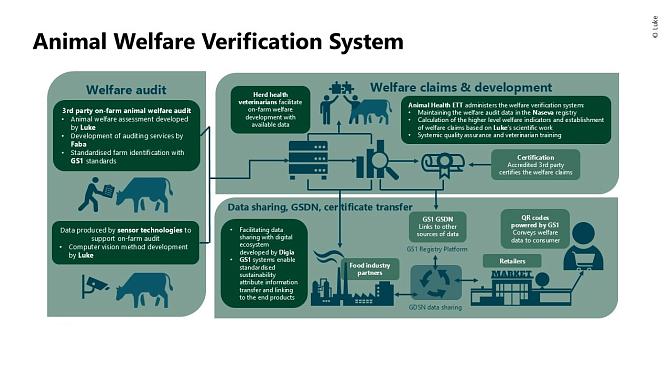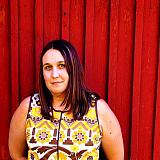Frequently asked questions about the AWVS project
What is the Animal Welfare Verification System (AWVS) project for?
The aim of the project is to establish a national animal welfare verification system for cattle based on the welfare assessment protocol work conducted at Luke (Natural Resources Institute Finland). The verification system measures the level of animal welfare and indicates the current state of welfare. It provides verified information on animal welfare to the entire food chain and utilizes this data to improve animal welfare on farms. Verifying the welfare of production animals enhances the overall societal acceptability of animal production.

What new elements does the system developed in the AWVS project bring to welfare monitoring?
Animal welfare assessment requires continuous development. The system we are building in the AWVS project takes into account all animal groups in the production chain—for example, the welfare of dairy calves and young stock is assessed and not only that of the dairy cows. The system modernizes welfare measurement, makes the calculation methods more transparent and fairer for producers, and improves the efficiency of audit visits by, for example, optimizing sample sizes for individual welfare indicators. We are building a dynamic system, which allows us to flexibly modify the existing framework as scientific knowledge increases and animal welfare improves.
How is the reliability of animal welfare measurements ensured in the system developed in the AWVS project?
Measuring animal welfare comprehensively and reliably is not straightforward—it always involves a compromise between reliability and feasibility. It is important for users of the data to understand what the measured welfare information is based on. In a perfect world, data collection would be continuous and cover every animal throughout its lifetime. In reality, welfare assessment involves a series of compromises: the used welfare indicators and background data must be selected, as do the sample of animals assessed, the timing of sampling and the method for aggregating results, and compensations and value judgments related to that.
A key aspect in selecting indicators is that they truly measure things that are relevant for the animals. The measurement method must also be reliable, meaning that the results should be consistent regardless of who conducts the measurement or the conditions under which the measurement is done. The goal is to produce results that are comparable across farms.
In the method development, we have taken the following aspects into account:
- In the selection of indicators, priority is given to animal-based measures, which assess welfare based on the animal itself. Animal-based indicators reflect the actual welfare of the animal more directly than resource- or management-based measures, which primarily evaluate the conditions that enable welfare.
- Typically, using animal-based indicators is more time-consuming than using resource-based indicators. Therefore, resource- and management-based indicators have been used when no cost-effective animal-based indicator is available, or when research has demonstrated a direct association between a resource-based measure and animal welfare.
- Sample size is one of the most significant factors affecting assessment time. To ensure reliability of a measurement, a sufficiently large proportion of animals on the farm must be assessed. For individual-level animal-based indicators, the sample size has been defined separately for each welfare indicator. The prevalence of the welfare indicator, its relevance to animal welfare, and the reliability of the measure are considered when defining the sample size.
- The welfare verification system is based on an audit conducted by an independent third party.
How are different aspects of welfare weighted in the assessment method?
Aggregating welfare data—i.e., summarizing it into scores by welfare domains—requires making value-based decisions about how different aspects of welfare are weighted in the calculations.¹ ²
- On-farm welfare data is aggregated according to different welfare domains. According to the Five Domains model, these domains are nutrition, health, living environment, behavior, and the animal’s mental state. The aggregation must also consider different animal groups within a farm.
- Welfare data is aggregated using various mathematical methods, but this requires value-based decisions informed by expert opinion. For example, lameness may be assigned a greater negative weight in the calculation than minor skin injuries.
- The aim is to consult a wide range of experts and stakeholders in making these value choices, including animal welfare scientists, veterinarians, representatives of the food industry, consumers, and animal welfare organizations. The specific stakeholders to be consulted will be determined during the project.
Consumers’ and citizens’ views on animal welfare do not always align with what scientific research has shown to be important for animal welfare. Value choices should aim to find a balance between public expectations and scientific facts in order for the verification system to gain broad acceptance.³ One goal of the project is also to explore how welfare data can be communicated in a clear and understandable way, so that stakeholder awareness of rscience-based animal welfare improves.
How does the system developed in the AWVS project contribute to improving animal welfare?
The verification system enables the goal-oriented development of animal welfare across a mass of farms. The results from the audit visits are directly available to herd health veterinarians. Primary producers receive valuable, detailed feedback from the assessment visit, showing the areas in which they have succeeded and the ones where further improvements in welfare are needed.
With the help of the data generated by the system, producers can work together with advisors, veterinarians, and other support services to plan how to improve animal welfare on their farm—and in some cases, also improve productivity.
Improving animal welfare is long-term work. We are building a dynamic system that can be flexibly developed further as scientific knowledge increases and the level of animal welfare improves. At the same time, the criteria for assessing animal welfare will become more precise.
Will the project produce an animal welfare label system?
The project does not develop an animal welfare label or labelling system for animal-based products. However, the food industry can use the data produced by the animal welfare verification system developed in the project to demonstrate compliance with the requirements of existing animal welfare labels.
Food companies may also use the welfare data in the way they see best when communicating about animal welfare to retailers and consumers, and to more easily monitor the development of animal welfare on their own production farms. In the future, this data may also be used as part of various actors’ labelling systems.
Both labelling and verification systems often function like quality systems. The principle of quality systems is continuous improvement of operations.
Why are we developing a new system instead of using existing ones?
The most commonly used animal welfare assessment and monitoring systems on Finnish cattle farms are the cattle health care monitoring system Naseva and the internationally developed Welfare Quality®. At Luke, we have been studying these systems since 2015 and identified the need to build a more comprehensive and transparent animal welfare measurement protocol. In 2021, we began developing a protocol for dairy cattle, and in 2023 for beef cattle. The system being developed in the AWVS project is based on these protocols. In the future, the system can be expanded to include other farm animal species as well.
What shortcomings exist in the current animal welfare assessment methods?
The European Food Safety Authority (EFSA) highlighted in its 2024 report (https://doi.org/10.2903/sp.efsa.2024.EN-8566) that the currently used animal welfare assessment methods are insufficient for large-scale evaluation of welfare. One area in need of development is the transparent aggregation of welfare data—that is, summarizing data into scores by welfare domains.
There are no previously published measurement protocols for assessing the welfare of dairy calves, young stock, or, for example, suckler cow herds. As a result, a large proportion of animals in the production chain are not currently covered by the existing assessment methods.
The project is creating a new system in collaboration with industry companies. How do we ensure the independence of a system developed together with businesses?
Luke is an independent organization, and in all our research, official duties, and statistical functions, we operate impartially, independently, honestly, and responsibly, following high standards of scientific ethics.
The development of protocols in this project is based on research and scientific ethics—not on conditions defined by indusrty. Collaboration with food industry companies ensures that the assessment protocols are broadly adopted in practice and do not remain merely theoretical. Implementing the animal welfare verification system in practice is a significant undertaking that also requires commitment from the industry. Developing the system in collaboration with companies helps ensuring its acceptance among users, which in turn accelerates implementation of the system and the improvement of animal welfare.
The system’s independence is assured by having audits on farms conducted by an independent third party.

